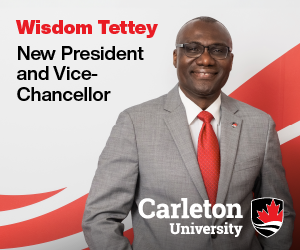The pandemic has exposed the need to better support international students
Experts say the ‘cash cow’ narrative belies policy challenges that need to be addressed.

Last August, as universities hustled to prepare for another semester at the whim of a pandemic, Ezgi Ozyonum was worrying about her fellow international students. A PhD candidate at Concordia University, Ms. Ozyonum knew all too well the challenges at hand. She taught students who had to wake up at all hours of the night to attend class from their home countries. She heard about their lingering stress from having to pack up and leave Canada on short notice, and their worry over whether they would be able to return.
As these students waited anxiously for direction on vaccines or travel restrictions, Ms. Ozyonum penned an op-ed for the Montreal Gazette, highlighting how the pandemic had disproportionately impacted international students. “I didn’t see that these students really had a voice,” she said. “The discourse was very dominant on how the Canadian institutions will survive without them. And I was really irritated, because the question should be: How do we support international students in this pandemic?”
In the 2021-2022 school year, the average tuition fees for international undergraduate students stood at $33,623, according to a recent report from Statistics Canada. “Increasingly, postsecondary institutions have relied on income from international students as part of their revenue stream,” the report stated. As the pandemic placed financial stress on schools across the country, an inevitable question arose about the hit budgets would take if fewer international students came to Canada because of the virus.
But for Ms. Ozyonum and others, the focus on numbers exposed a larger problem. International students were being viewed narrowly as “cash cows,” an image that negates their unique contributions. “I don’t think any university or nation should be known as, ‘They just welcome others because of their money,’” Ms. Ozyonum said.
Indeed, Canada’s international education strategy repeatedly highlights the economic potential of students who come from abroad. Millions of dollars have been earmarked for both overseas recruitment and streamlining the approval process for interested students. Yet as the pandemic made clear, support often falls short once they arrive.
Improving services, communication
Saba Safdar, a professor of psychology at the University of Guelph, studies the experiences of international students in Canada. She said while most schools have international education offices or other services available, they’re not always able to meet students’ needs. “It’s good to increase the number of international students,” Dr. Safdar said. “But we need our campuses to be equipped to deal with them.”
Tackling the demands of university while navigating different social norms and educational structures can be very difficult. While students in general are vulnerable to mental health challenges, research by both Dr. Safdar and Ms. Ozyonum shows international students face increased risks of problems with anxiety and depression.
Ms. Ozyonum has found that at many schools, communication about services tends to be the problem. Information either doesn’t reach international students or isn’t culturally sensitive (for example, failing to take into account that mental health issues may be more stigmatized). This created the perfect storm when the pandemic hit, and information was rapidly evolving and often incomplete. Some university policies also left out those who had returned to their home countries, leaving them unable to access mental health counselling at their institution.
Bipin Kumar, the international students’ commissioner at the Canadian Federation of Students, heard similar stories. Although all students were affected by campus shutdowns, Mr. Kumar pointed out that international students tend to rely much more on campus services, eating in meal halls, participating in clubs, or working on-campus jobs. One result, Mr. Kumar said, is that some “have missed having what you call the ‘Canadian experience.’”
Not only does the “cash cow” narrative de-tract from the weight of these challenges, Ms. Ozyonum said, but it also misses the fact that many international students struggle financially. One survey at Western University found that 81 per cent of international graduate students face financial problems, mainly because of budgeting issues or currency conversion against the Canadian dollar (which became a bigger issue as some foreign currencies fell against the loonie amid the pandemic). International students are also excluded from major federal and provincial scholarships or funding grants, such as those awarded by the Tri-Councils. In 2017, that rule changed for the Quebec equivalent, which is disbursed by the Fonds de recherche du Québec, but Ms. Ozyonum says changing the rules nationally would be a big step forward.
Pathway to permanent residency
For students who want to live and work in Canada after their studies, the process can be uncertain. Mr. Kumar said one of the main changes he and his colleagues at the Canadian Federation of Students would like to see is a direct pathway to permanent residency after graduation. The concept is mentioned in Canada’s international education strategy, but apart from funding for increased immigration services, it’s not clear how or when it will be created.
Dr. Safdar said the international education strategy relies on the assumption that once students attend school in Canada, they’ll have a better chance to gain work experience. She’s wrapping up a study that suggests the situation is far more complex. Her main finding has been that international students have limited social networks compared to domestic students, and that’s a major hindrance. “Canadian students tend to report that they find jobs through both formal and informal networks – friends and relatives and parents,” she said, whereas this is less likely in the case of international students.
These gaps present a curious paradox: while universities are becoming increasingly dependent on the financial contribution of international students, by not supporting them in a more robust way, the country as a whole may be missing out on much more. Ms. Ozyonum suggests focusing more on the long-term, holistic contribution these students can make. “Canada has this vision that they really promote diverse communities, by being that multicultural nation,” she said. “So in that way, international students really contribute to Canada’s overall vision.”
Featured Jobs
- Accounting - Tenured or Tenure-Track Faculty PositionUniversity of Alberta
- Psychology - Assistant Professor (Social)Mount Saint Vincent University
- Electrical and Computer Engineering - Assistant/Associate ProfessorWestern University
- Indigenous Studies - Faculty PositionUniversité Laval
- Electrical Engineering - Assistant Professor (Electromagnetic/Photonic Devices and Systems)Toronto Metropolitan University















Post a comment
University Affairs moderates all comments according to the following guidelines. If approved, comments generally appear within one business day. We may republish particularly insightful remarks in our print edition or elsewhere.